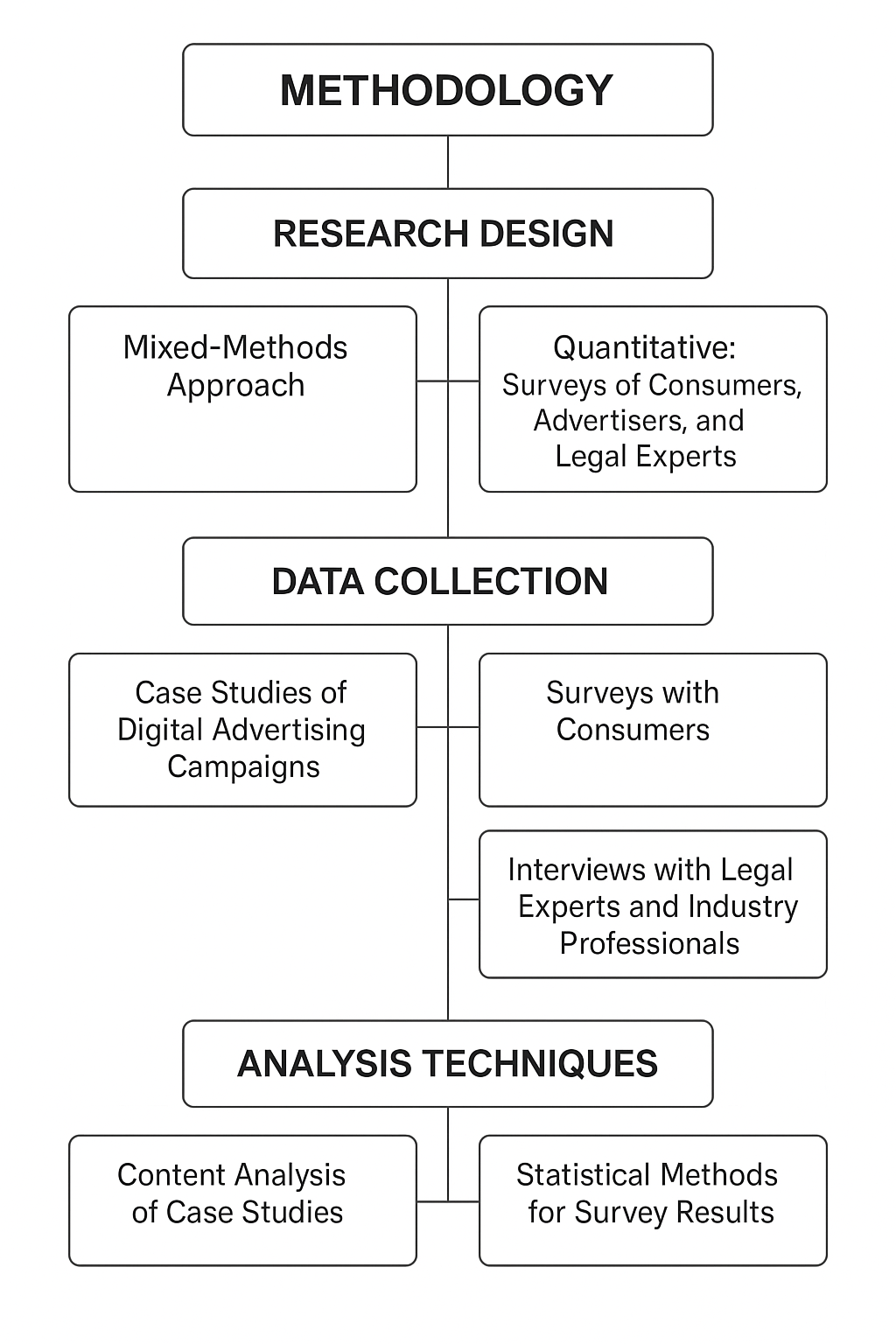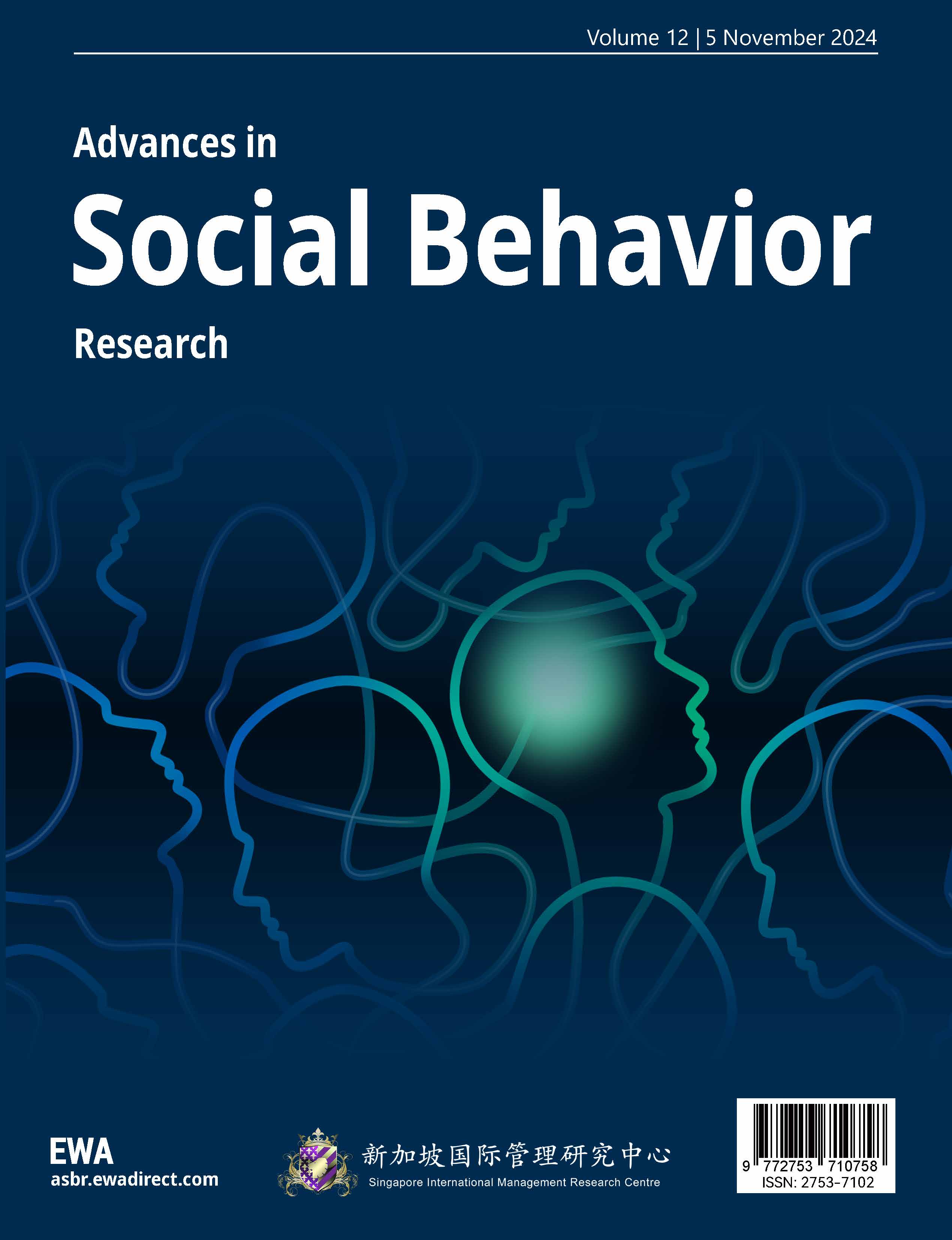1. Introduction
The digital advertising industry has undergone profound changes in recent years due to the widespread use of intelligent algorithms and data tracking technology. Precise pushes based on real-time user profiles have significantly improved marketing effectiveness, but they also create new risks that traditional advertising methods are difficult to address. When decision-making logic is buried in algorithmic black boxes, consumers often have no way of knowing how their behavioral data is collected and analyzed, let alone understanding how it affects their consumption choices. This opacity not only undermines user autonomy but also opens up opportunities for inductive marketing targeting vulnerable groups. The global nature of cross-border digital advertising adds to regulatory complexity as companies navigate institutional differences between jurisdictions. While regulations such as the EU General Data Protection Regulation have established a basic framework, most regions have yet to develop specific legislation on fundamental issues such as algorithmic transparency and user empowerment. Current regulatory measures generally lag behind the iteration speed of technology, making it difficult to address violations such as threatening advertising in a timely manner [1]. Through case analysis, user research, and other multidimensional demonstrations, this study systematically evaluates the protective effectiveness of the current legal system, reveals institutional blind spots in the algorithmic recommendation mechanism, and provides reform guidance for building a transparent and credible digital advertising governance system.
2. Literature review
2.1. Legal frameworks in digital advertising
The iteration rate of digital advertising technologies continues to challenge the global regulatory system's ability to respond. As shown in Figure 1, current network marketing has formed a multi-channel communication model spanning websites, social media, and video platforms, and each channel has faced specific regulatory challenges. While the EU's General Data Protection Regulation and other regulations govern data collection, user authorization, and other aspects, unifying global standards is difficult due to differences between national systems [2]. Differences in privacy regimes across countries have led to rising compliance costs for multinational companies, while there are still significant gaps in legislation specifically regulating algorithmic advertising. Current regulation still focuses on the data collection link, and the transparent mechanism for reviewing and correcting algorithmic decision-making has not yet formed effective constraints, and consumers' rights and interests face the dual threat of algorithmic bias and the difficulty of identifying responsibility.

Figure 1. Key channels and regulatory touchpoints in the digital advertising ecosystem (source:newszii.com)
2.2. Ethical implications of data-driven advertising
While improving marketing effectiveness, data-driven precision advertising faces ethical controversy over excessive intervention in user choice. While user profiles built on behavioral data can achieve precise advertising reach, they can also evolve into an induction tool for specific groups. When advertisers take advantage of a user's mood swings or consumer weaknesses (such as targeting addictive products), consumers are often unintentionally influenced in their decisions. This hidden manipulation mechanism poses a particular risk to vulnerable groups such as adolescents. The key to ethical marketing is to establish a mechanism that balances commercial interests and user autonomy and to ensure that data applications do not cross the boundaries of personal choice through technical transparency [3].
2.3. Consumer trust and advertising transparency
Digital advertising faces a fundamental challenge in rebuilding trust. Consumers are increasingly concerned about advertisers' motives for using data, particularly regarding the boundaries between the collection and use of personal information. Transparency in advertising delivery mechanisms has become a key element in restoring trust, and research data shows that users are more likely to interact with brands with clear data usage rules. Improper operations such as false advertising titles and induced pricing strategies not only infringe on consumers' rights and interests, but also easily lead to legal disputes and corporate reputational crises [4]. Establishing an open and transparent operating mechanism is the only way to ensure the sustainable development of digital advertising.
3. Experimental methodology
3.1. Research design
As shown in the first module of Figure 2, the research first establishes the analysis framework corresponding to the technical characteristics of algorithmic advertising and the legal risk elements. This paper adopts the qualitative method of policy text interpretation and typical case analysis, combined with the quantitative means of structured questionnaire survey and data modeling to form a composite research model [5]. This design can not only deeply analyze the internal logic of regulatory standards, but also obtain the actual impact evidence of algorithm application through massive user data, so as to establish an empirical bridge between system design and user experience, and realize the organic integration of legal evaluation and digital marketing practice.
3.2. Data collection
As shown in the second step of Figure 2, a three-way parallel data collection strategy was adopted to ensure the reliability of the conclusion. First, representative cases of digital advertising violations were selected and two typical scenarios of false propaganda and data transgression were analyzed. Second, a tripartite questionnaire was developed for consumers, lawyers, and advertisers to systematically collect cognitive differences in privacy protection and advertising transparency [6]. Finally, in-depth interviews were conducted with industry practitioners and regulators to obtain realistic dilemmas and improvement suggestions in system implementation. This cross-validation mechanism of multiple data sources effectively improves the practical guiding value of the research results.
3.3. Analysis techniques
As shown in the last link in Figure 2, the mixed analysis method was adopted in the research to conduct in-depth data exploration. For qualitative data, using the subject code of legal documents and case documents, extract core issues such as algorithm abuse and authorization defects; In quantitative data, descriptive statistics are used to present users' cognitive distribution, and regression analysis is combined to reveal the correlation law between advertising ethical perception and trust [7]. This complementary mechanism of quantitative and qualitative research ensures that the research results are not only supported by data, but also reflect realistic problems, thus providing a basis for formulating accurate governance programs. The innovation of the entire methodology is to break the barriers between legal text analysis and user behavior research, and to provide an operational improvement path for building a benign digital advertising ecology.

Figure 2. Research methodology flowchar
4. Results and discussion
4.1. False advertising practices
Research data reveals that the problem of misleading advertising on digital platforms is particularly acute in high-risk areas such as health products, beauty, and financial management. The case database contains a large number of illegal forms, such as exaggerated efficacy propaganda, inconsistent graphics, and misleading prices, such as the promotion of unapproved healthcare products as treatments for chronic diseases [8]. As shown in Table 1, 37.8% of respondents experienced misleading advertising in the past three months, of which 62.4% reported a strong sense of fraud or actual financial losses. Despite the continuous strengthening of supervision, the platform's response speed still lags behind—only 58% of illegal ads in reported cases were removed within two weeks, revealing the operational shortcomings of the real-time supervision mechanism [9].
Table 1. Consumer encounters with false advertising on digital platforms
Advertising Sector | % Encountering Misleading Ads | % Reporting Harm or Deception |
Health Products | 45.2% | 69.1% |
Financial Services | 38.6% | 58.3% |
Skincare & Cosmetics | 31.4% | 52.7% |
Tech Gadgets & Tools | 26.8% | 41.9% |
Overall Average | 37.8% | 62.4% |
These results suggest that while legal instruments exist to address false advertising, platform-level enforcement and consumer compensation remain insufficient. The findings support calls for more proactive content screening systems and greater legal accountability for platforms hosting such ads.
4.2. Privacy violations in data-driven advertising
Current digital advertising privacy protections face systemic challenges. Through cross-platform tracking and cooperation with third-party data providers, intelligent recommendation systems continue to incorporate user behavioral characteristics to build accurate profiles, but in most cases, they are not fully authorized. As shown in Table 2, only 23.5% of respondents could clearly explain how personal data is used for advertising purposes. It is noteworthy that 34% of respondents explicitly reported receiving “intrusive and highly targeted” ads, reflecting the risk of exceeding data collection limits [10]. More notably, nearly half of consumers (47.3%) were unaware that their browsing history could be shared with third parties, revealing substantial flaws in the user authorization mechanism.
Table 2. Consumer awareness and experience with data-driven advertising
Category | Percentage (%) |
Fully aware of how data is used | 23.5% |
Received suspiciously specific ad content | 34.0% |
Unaware data may be shared with third-party | 47.3% |
Believe consent process is insufficient | 52.7% |
Feel privacy has been violated | 38.9% |
These results illustrate the lack of transparency and insufficient consumer education regarding digital tracking and profiling. While legal measures like GDPR attempt to establish clearer consent protocols, enforcement is often reactive rather than preventive. The persistence of such violations calls for stricter monitoring, clearer opt-in requirements, and penalties proportionate to the scale of data misuse.
4.3. Consumer manipulation and ethical concerns
Research reveals that predictive algorithmic advertising has profound ethical issues. Through cross-platform behavior tracking, advertisers can accurately capture users' psychological fluctuations and behavioral characteristics, then deliver highly targeted, inductive content. This type of "sniper" marketing breaches the bottom line of business ethics while improving conversion rates—interview data shows that young people, impulsive consumers, and emotionally disturbed individuals are more likely to receive risky ads such as gambling platforms and high-interest online loans [11]. This type of targeted pressure not only infringes on users' right to make independent decisions, but can also lead to addictive behavior or exacerbate financial crises. The current system has obvious gaps in the ethical review of the push algorithm, and there is an urgent need to establish a comprehensive governance framework including the ethical assessment of algorithms, a mechanism for prior review of advertising content and a mandatory disclosure system, so as to limit the lasting harm of technology abuse for vulnerable groups [12].
5. Conclusion
This research system reveals the legal blind spots and ethical irregularities in algorithmic recommendation advertising. Empirical data shows that the three risks of false advertising, privacy violation, and induced consumption are intertwined and pervasive. Although the current regulatory system has established a basic framework, there are delayed responses and institutional gaps, particularly in the areas of algorithmic transparency and cross-border data governance. Consumer awareness of data collection applications is clearly insufficient, and most users struggle to accurately grasp the path of personal data and its impact on consumption decisions. The use of algorithmic black boxes by platforms and advertisers to set precise incentives for vulnerable groups has become a new source of risk to undermine digital trust. Therefore, it is suggested to establish a dynamic negative list and a review mechanism for algorithmic filings, and promote the regulatory focus from single privacy protection to full-chain fairness. Further studies should integrate perspectives from law, information technology, and other disciplines, focus on the impact of generative artificial intelligence technology on advertising ethics, and explore the construction of an intelligent advertising governance paradigm with user rights as the central focus.
References
[1]. Duivenvoorde, B., & Goanta, C. (2023). The regulation of digital advertising under the DSA: A critical assessment. Computer Law & Security Review, 51, 105870.
[2]. Kokshagina, O., Reinecke, P. C., & Karanasios, S. (2023). To regulate or not to regulate: unravelling institutional tussles around the regulation of algorithmic control of digital platforms. Journal of Information Technology, 38(2), 160-179.
[3]. Ulbricht, L., & Yeung, K. (2022). Algorithmic regulation: A maturing concept for investigating regulation of and through algorithms. Regulation & Governance, 16(1), 3-22.
[4]. Ershov, D., & Mitchell, M. (2025). The effects of advertising disclosure regulations on social media: Evidence from Instagram. The RAND Journal of Economics, 56(1), 74-90.
[5]. Bietti, E. (2023). A genealogy of digital platform regulation. Geo. L. Tech. Rev., 7(1), 1.
[6]. Saurwein, F., & Spencer-Smith, C. (2021). Automated trouble: The role of algorithmic selection in harms on social media platforms. Media and Communication, 9(4), 222-233.
[7]. Bellanova, R., & De Goede, M. (2022). The algorithmic regulation of security: An infrastructural perspective. Regulation & governance, 16(1), 102-118.
[8]. Baskaran, S., et al. (2021). Determinants of Consumer Perceived Trustworthiness in Digital Advertising of Food and Beverage. International Journal of Academic Research in Business and Social Sciences, 11(8), 60-77.
[9]. Nair, K., & Gupta, R. (2021). Application of AI technology in modern digital marketing environment. World Journal of Entrepreneurship, Management and Sustainable Development, 17(3), 318-328.
[10]. Cozzolino, A., Corbo, L., & Aversa, P. (2021). Digital platform-based ecosystems: The evolution of collaboration and competition between incumbent producers and entrant platforms. Journal of Business Research, 126, 385-400.
[11]. Faruk, M., Rahman, M., & Hasan, S. (2021). How digital marketing evolved over time: A bibliometric analysis on scopus database. Heliyon, 7(12).
[12]. Vashishtha, S., & Sharma, P. (2024). Artificial Intelligence and More Effective Advertising: Unlocking the Power of Data and Automation. In Advances in Digital Marketing in the Era of Artificial Intelligence (pp. 162-171). CRC Press.
Cite this article
Cheng,X. (2025). Legal and ethical challenges in digital advertising: addressing false advertising, privacy violations, and consumer manipulation through algorithmic and data-driven advertising systems. Advances in Social Behavior Research,16(3),150-154.
Data availability
The datasets used and/or analyzed during the current study will be available from the authors upon reasonable request.
Disclaimer/Publisher's Note
The statements, opinions and data contained in all publications are solely those of the individual author(s) and contributor(s) and not of EWA Publishing and/or the editor(s). EWA Publishing and/or the editor(s) disclaim responsibility for any injury to people or property resulting from any ideas, methods, instructions or products referred to in the content.
About volume
Journal:Advances in Social Behavior Research
© 2024 by the author(s). Licensee EWA Publishing, Oxford, UK. This article is an open access article distributed under the terms and
conditions of the Creative Commons Attribution (CC BY) license. Authors who
publish this series agree to the following terms:
1. Authors retain copyright and grant the series right of first publication with the work simultaneously licensed under a Creative Commons
Attribution License that allows others to share the work with an acknowledgment of the work's authorship and initial publication in this
series.
2. Authors are able to enter into separate, additional contractual arrangements for the non-exclusive distribution of the series's published
version of the work (e.g., post it to an institutional repository or publish it in a book), with an acknowledgment of its initial
publication in this series.
3. Authors are permitted and encouraged to post their work online (e.g., in institutional repositories or on their website) prior to and
during the submission process, as it can lead to productive exchanges, as well as earlier and greater citation of published work (See
Open access policy for details).
References
[1]. Duivenvoorde, B., & Goanta, C. (2023). The regulation of digital advertising under the DSA: A critical assessment. Computer Law & Security Review, 51, 105870.
[2]. Kokshagina, O., Reinecke, P. C., & Karanasios, S. (2023). To regulate or not to regulate: unravelling institutional tussles around the regulation of algorithmic control of digital platforms. Journal of Information Technology, 38(2), 160-179.
[3]. Ulbricht, L., & Yeung, K. (2022). Algorithmic regulation: A maturing concept for investigating regulation of and through algorithms. Regulation & Governance, 16(1), 3-22.
[4]. Ershov, D., & Mitchell, M. (2025). The effects of advertising disclosure regulations on social media: Evidence from Instagram. The RAND Journal of Economics, 56(1), 74-90.
[5]. Bietti, E. (2023). A genealogy of digital platform regulation. Geo. L. Tech. Rev., 7(1), 1.
[6]. Saurwein, F., & Spencer-Smith, C. (2021). Automated trouble: The role of algorithmic selection in harms on social media platforms. Media and Communication, 9(4), 222-233.
[7]. Bellanova, R., & De Goede, M. (2022). The algorithmic regulation of security: An infrastructural perspective. Regulation & governance, 16(1), 102-118.
[8]. Baskaran, S., et al. (2021). Determinants of Consumer Perceived Trustworthiness in Digital Advertising of Food and Beverage. International Journal of Academic Research in Business and Social Sciences, 11(8), 60-77.
[9]. Nair, K., & Gupta, R. (2021). Application of AI technology in modern digital marketing environment. World Journal of Entrepreneurship, Management and Sustainable Development, 17(3), 318-328.
[10]. Cozzolino, A., Corbo, L., & Aversa, P. (2021). Digital platform-based ecosystems: The evolution of collaboration and competition between incumbent producers and entrant platforms. Journal of Business Research, 126, 385-400.
[11]. Faruk, M., Rahman, M., & Hasan, S. (2021). How digital marketing evolved over time: A bibliometric analysis on scopus database. Heliyon, 7(12).
[12]. Vashishtha, S., & Sharma, P. (2024). Artificial Intelligence and More Effective Advertising: Unlocking the Power of Data and Automation. In Advances in Digital Marketing in the Era of Artificial Intelligence (pp. 162-171). CRC Press.









